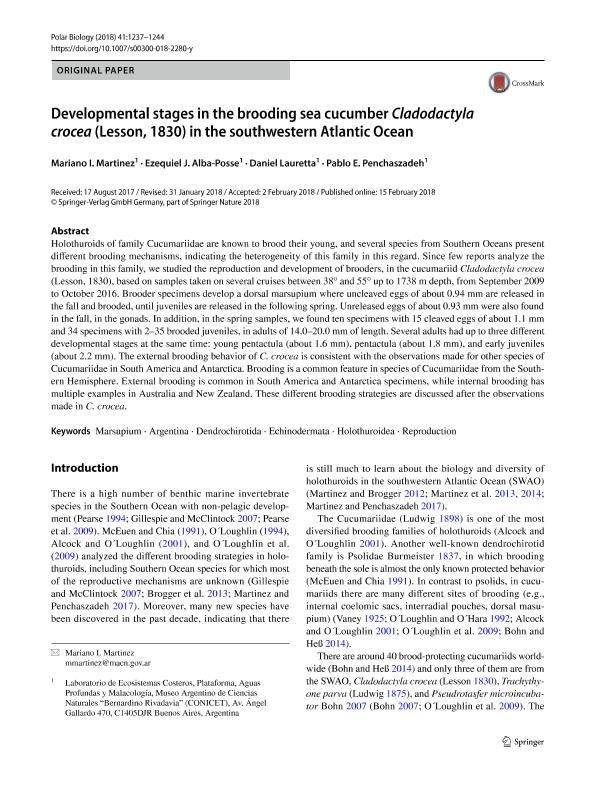Mostrar el registro sencillo del ítem
dc.contributor.author
Martinez, Mariano Ignacio

dc.contributor.author
Alba Posse, Jorge Ezequiel

dc.contributor.author
Lauretta, Daniel Marcelo

dc.contributor.author
Penchaszadeh, Pablo Enrique

dc.date.available
2019-12-30T14:45:25Z
dc.date.issued
2018-06
dc.identifier.citation
Martinez, Mariano Ignacio; Alba Posse, Jorge Ezequiel; Lauretta, Daniel Marcelo; Penchaszadeh, Pablo Enrique; Developmental stages in the brooding sea cucumber Cladodactyla crocea (Lesson, 1830) in the southwestern Atlantic Ocean; Springer; Polar Biology; 41; 6; 6-2018; 1237-1244
dc.identifier.issn
0722-4060
dc.identifier.uri
http://hdl.handle.net/11336/93203
dc.description.abstract
Holothuroids of family Cucumariidae are known to brood their young, and several species from Southern Oceans present different brooding mechanisms, indicating the heterogeneity of this family in this regard. Since few reports analyze the brooding in this family, we studied the reproduction and development of brooders, in the cucumariid Cladodactyla crocea (Lesson, 1830), based on samples taken on several cruises between 38° and 55° up to 1738 m depth, from September 2009 to October 2016. Brooder specimens develop a dorsal marsupium where uncleaved eggs of about 0.94 mm are released in the fall and brooded, until juveniles are released in the following spring. Unreleased eggs of about 0.93 mm were also found in the fall, in the gonads. In addition, in the spring samples, we found ten specimens with 15 cleaved eggs of about 1.1 mm and 34 specimens with 2–35 brooded juveniles, in adults of 14.0–20.0 mm of length. Several adults had up to three different developmental stages at the same time: young pentactula (about 1.6 mm), pentactula (about 1.8 mm), and early juveniles (about 2.2 mm). The external brooding behavior of C. crocea is consistent with the observations made for other species of Cucumariidae in South America and Antarctica. Brooding is a common feature in species of Cucumariidae from the Southern Hemisphere. External brooding is common in South America and Antarctica specimens, while internal brooding has multiple examples in Australia and New Zealand. These different brooding strategies are discussed after the observations made in C. crocea.
dc.format
application/pdf
dc.language.iso
eng
dc.publisher
Springer

dc.rights
info:eu-repo/semantics/openAccess
dc.rights.uri
https://creativecommons.org/licenses/by-nc-sa/2.5/ar/
dc.subject
Marsupium
dc.subject
Argentina
dc.subject
Dendrochirotida
dc.subject
Echinodermata
dc.subject
Holothuroidea
dc.subject
Reproduction
dc.subject
Marsupium
dc.subject
Reproduction
dc.subject.classification
Ecología

dc.subject.classification
Ciencias Biológicas

dc.subject.classification
CIENCIAS NATURALES Y EXACTAS

dc.subject.classification
Ecología

dc.subject.classification
Ciencias Biológicas

dc.subject.classification
CIENCIAS NATURALES Y EXACTAS

dc.title
Developmental stages in the brooding sea cucumber Cladodactyla crocea (Lesson, 1830) in the southwestern Atlantic Ocean
dc.type
info:eu-repo/semantics/article
dc.type
info:ar-repo/semantics/artículo
dc.type
info:eu-repo/semantics/publishedVersion
dc.date.updated
2019-10-16T19:28:06Z
dc.journal.volume
41
dc.journal.number
6
dc.journal.pagination
1237-1244
dc.journal.pais
Alemania

dc.journal.ciudad
Berlin
dc.description.fil
Fil: Martinez, Mariano Ignacio. Consejo Nacional de Investigaciones Científicas y Técnicas. Oficina de Coordinación Administrativa Parque Centenario. Museo Argentino de Ciencias Naturales “Bernardino Rivadavia”; Argentina
dc.description.fil
Fil: Alba Posse, Jorge Ezequiel. Consejo Nacional de Investigaciones Científicas y Técnicas. Oficina de Coordinación Administrativa Parque Centenario. Museo Argentino de Ciencias Naturales “Bernardino Rivadavia”; Argentina
dc.description.fil
Fil: Lauretta, Daniel Marcelo. Consejo Nacional de Investigaciones Científicas y Técnicas. Oficina de Coordinación Administrativa Parque Centenario. Museo Argentino de Ciencias Naturales “Bernardino Rivadavia”; Argentina
dc.description.fil
Fil: Penchaszadeh, Pablo Enrique. Consejo Nacional de Investigaciones Científicas y Técnicas. Oficina de Coordinación Administrativa Parque Centenario. Museo Argentino de Ciencias Naturales “Bernardino Rivadavia”; Argentina
dc.journal.title
Polar Biology

dc.relation.alternativeid
info:eu-repo/semantics/altIdentifier/url/http://link.springer.com/10.1007/s00300-018-2280-y
dc.relation.alternativeid
info:eu-repo/semantics/altIdentifier/doi/https://doi.org/10.1007/s00300-018-2280-y
Archivos asociados
